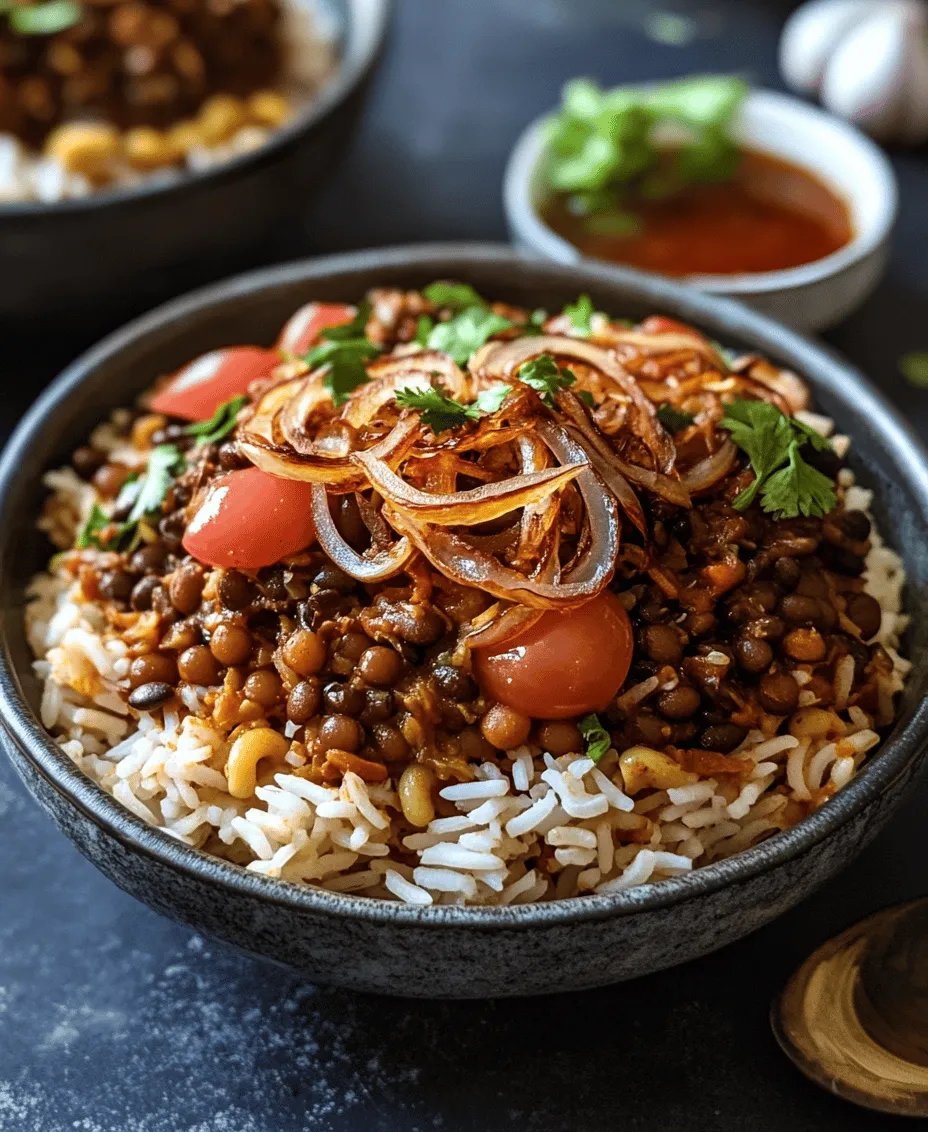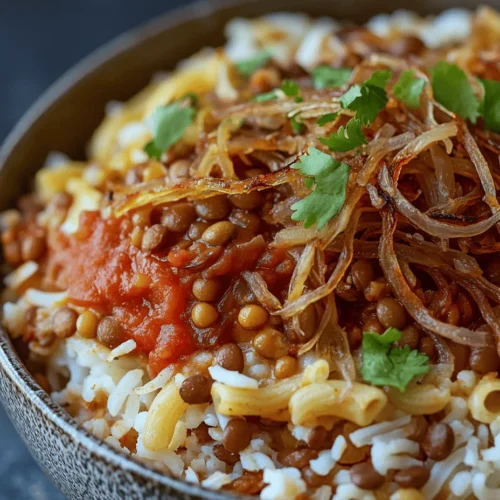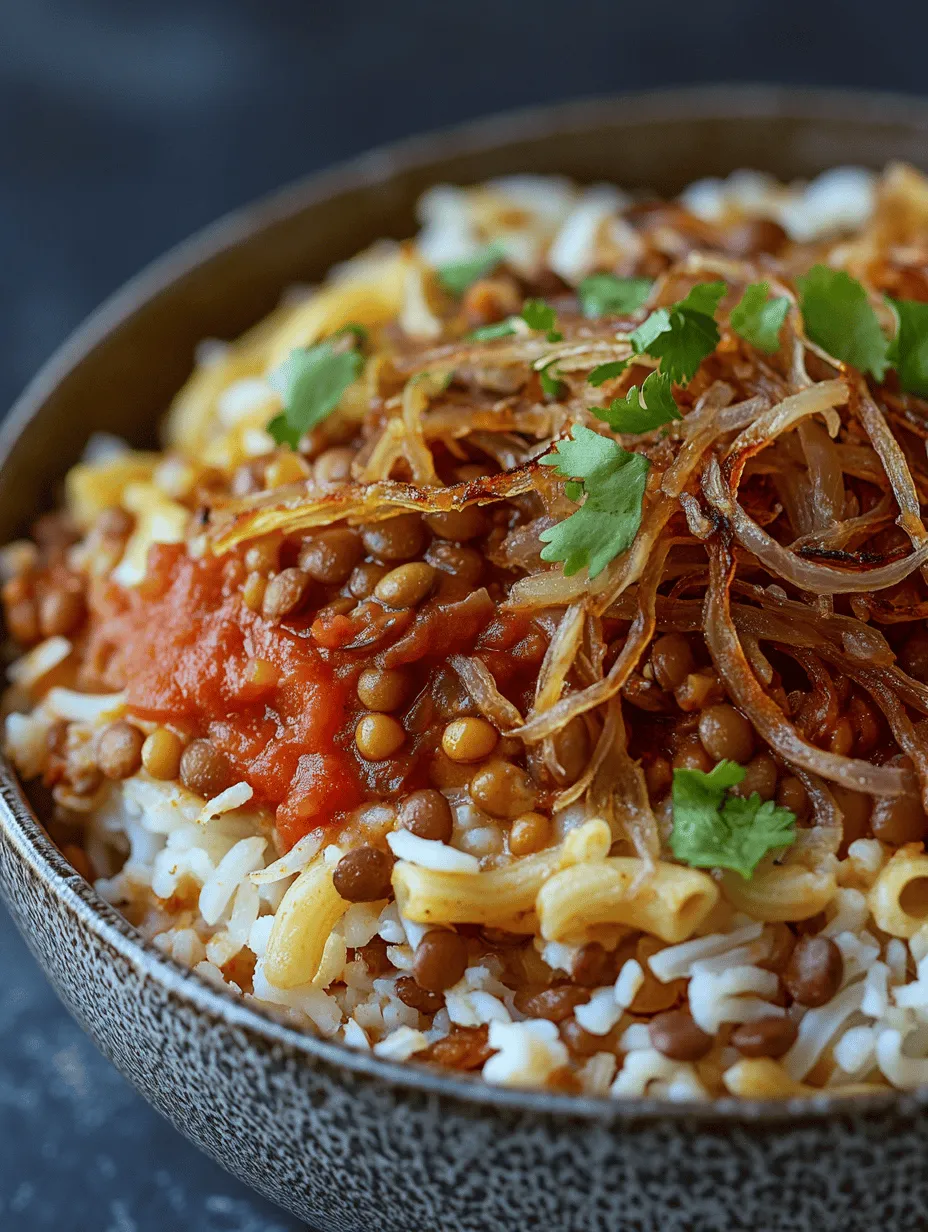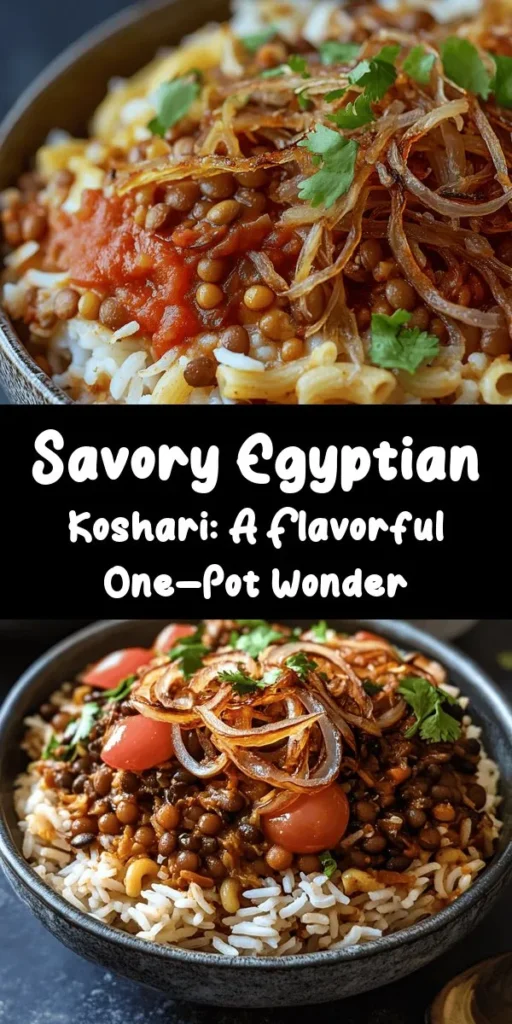Introduction to Authentic Egyptian Koshari Delight
Koshari, often hailed as Egypt’s national dish, is a delightful amalgamation of flavors, textures, and aromas that epitomizes the heart of Egyptian cuisine. This beloved dish is not just a meal; it is a cultural symbol, enjoyed by locals and tourists alike, served from bustling street carts to family dining tables. Koshari is the embodiment of comfort food in Egypt, cherished for its filling nature and nutritious ingredients that come together to create a satisfying experience.
The origins of Koshari are as rich and intriguing as the meal itself. It is said to have been influenced by a blend of culinary traditions, incorporating elements from Italian pasta, Indian lentils, and the local Egyptian palate. Over time, Koshari has evolved into a beloved staple, often enjoyed during lunch or dinner and frequently garnished with a tangy tomato sauce, crispy onions, and a sprinkle of chickpeas. This dish not only reflects the culinary diversity of Egypt but also serves as a testament to the country’s vibrant street food culture.
In this article, we will explore the various components that make Koshari a unique and flavorful dish. We will also provide a step-by-step guide to preparing this delightful meal, ensuring you can recreate the authentic taste of Egypt in your own kitchen.
Understanding the Ingredients of Koshari
To appreciate the depth of flavor in Koshari, it is essential to understand its key components. Each ingredient plays a vital role in contributing to the dish’s unique profile, making it a balanced and hearty meal.
Lentils: The Heart of Koshari
At the core of Koshari lies the humble lentil, a powerhouse of nutrition and flavor. Lentils are rich in protein, fiber, and essential vitamins, making them a staple in many diets around the world. In Koshari, the most commonly used varieties are brown or black lentils, each bringing its own characteristics to the dish.
Brown lentils are known for their earthy flavor and firm texture, which hold up well during cooking. They require minimal preparation, making them a convenient choice for busy cooks. On the other hand, black lentils, also known as beluga lentils, are slightly sweeter and have a firmer texture, adding an appealing contrast to the dish. When cooked properly, lentils provide a robust foundation for the other ingredients, enhancing the overall heartiness of Koshari.
Rice: The Base Layer
Rice serves as the foundation of Koshari, providing a comforting base upon which the other ingredients can shine. Medium-grain rice is preferred for this dish due to its ability to absorb flavors while maintaining a slightly chewy texture. The cooking process is crucial; the rice should be cooked until fluffy and tender but not mushy, ensuring it complements the other components without overwhelming them.
To achieve the perfect rice, it is essential to rinse it thoroughly before cooking. This step removes excess starch, preventing the rice from clumping together. When cooked with the right amount of water, the rice will create a light and airy layer, serving as the perfect canvas for the lentils, macaroni, and sauce that follow.
Macaroni: Adding Variety
Macaroni brings an element of comfort and familiarity to Koshari, rounding out the dish with its soft, chewy texture. The most commonly used shapes are small elbow macaroni or ditalini. These pasta shapes are ideal for capturing the flavors of the sauce while adding a delightful bite to each mouthful.
The addition of macaroni not only enhances the dish’s texture but also adds a playful contrast to the other ingredients. As the macaroni cooks, it absorbs the rich flavors from the spices and sauce, making each bite a harmonious blend of tastes.
Aromatics: Onions and Garlic
No Koshari is complete without the aromatic duo of onions and garlic. The process of caramelizing onions is pivotal, as it transforms their natural sweetness and adds a depth of flavor that is integral to the dish. When cooked slowly over medium heat, onions develop a golden-brown color, creating a rich, savory base that enhances the overall taste of Koshari.
Garlic, on the other hand, is used to elevate the dish’s aroma and provide a burst of flavor. When sautéed alongside the caramelized onions, garlic infuses the entire dish with its fragrant essence, making it irresistible. Together, these aromatics form the backbone of Koshari, grounding the dish in a robust flavor profile.
Tomatoes: The Flavor Booster
Tomatoes are the secret weapon in Koshari, contributing a vibrant acidity that balances the dish’s rich flavors. Crushed tomatoes and tomato paste are typically used in the sauce, providing a rich and tangy base. To elevate the complexity of the sauce, spices such as cumin, paprika, and cayenne pepper are incorporated, creating a well-rounded flavor that enhances the entire dish.
The spices not only add warmth and depth but also bring a touch of heat that can be adjusted to suit individual preferences. This combination ensures that each spoonful of Koshari is bursting with flavor, making it a truly satisfying meal.
Chickpeas: A Nutritional Powerhouse
Chickpeas are another essential component of Koshari, both for their texture and nutritional benefits. These legumes add a delightful creaminess to the dish, complementing the other ingredients while also contributing to the overall heartiness. Rich in protein and fiber, chickpeas enhance the dish’s nutritional profile, making it an excellent choice for anyone seeking a filling and healthy meal.
In Koshari, chickpeas are often added as a garnish, providing a satisfying crunch that contrasts beautifully with the soft lentils and rice. This addition not only increases the dish’s visual appeal but also ensures that every bite is packed with flavor and nutrition.
Olive Oil: The Essential Fat
Finally, olive oil plays a crucial role in the preparation of Koshari. It is used for sautéing the onions and garlic, contributing to their caramelization while adding a rich, fruity flavor to the dish. Olive oil is not only a healthier fat option but also enhances the overall taste of Koshari, bringing the various flavors together harmoniously.
In addition to sautéing, a drizzle of high-quality olive oil can be added just before serving, elevating the dish to new heights of flavor. This finishing touch is a hallmark of Egyptian cuisine, demonstrating the importance of quality ingredients in creating an authentic culinary experience.
Step-by-Step Preparation of Koshari
Now that we understand the essential components of Koshari, let’s dive into the step-by-step preparation process. Making Koshari may seem daunting at first, but with a bit of organization and patience, you can achieve perfect results that will impress your family and friends.
Preparing the Lentils
Begin by rinsing the lentils under cold water to remove any impurities. It’s crucial to inspect the lentils for any foreign debris or stones before cooking. After rinsing, place the lentils in a pot with water, ensuring there is enough liquid to cover them by about an inch. Bring the water to a boil, then reduce the heat to a simmer.
Cooking the lentils properly is key to achieving the right texture. You will want to avoid overcooking them, as they should be tender yet firm, holding their shape when mixed with the other ingredients. This process typically takes about 15-20 minutes. Once cooked, drain the lentils and set them aside, ready to be layered into your Koshari.
By understanding the role of each ingredient and following the preparation steps meticulously, you will be well on your way to creating an authentic Egyptian Koshari Delight that is sure to impress. Stay tuned for the next part of this article, where we will continue with the preparation of rice and macaroni, and delve deeper into the sauce that brings this dish to life.

Cooking the Rice
To create the perfect fluffy rice for your Koshari, begin by rinsing 1 cup of long-grain rice under cold water. This process removes excess starch, preventing the rice from becoming sticky during cooking.
In a medium saucepan, combine the rinsed rice with 1.5 cups of water, a pinch of salt, and a splash of olive oil. Bring this mixture to a boil over medium-high heat. Once it reaches a boil, reduce the heat to low, cover the pot, and let it simmer for about 15-20 minutes. It’s crucial not to lift the lid during this time, as the steam is essential for cooking the rice evenly. After the cooking time, turn off the heat and let the rice rest for an additional 5-10 minutes, still covered. This resting period allows the rice to absorb any remaining moisture. Finally, fluff the rice with a fork to separate the grains before you layer it into your Koshari.
Boiling the Macaroni
Cooking the macaroni is a straightforward process, but timing is key to achieving that perfect al dente texture. Begin by bringing a large pot of salted water to a rolling boil. Add 1 cup of elbow macaroni to the pot and stir occasionally to prevent sticking.
Cook the macaroni according to the package instructions, usually around 7-9 minutes. Make sure to taste it a minute or two before the suggested cooking time to ensure you achieve the desired firmness. Once cooked, drain the macaroni in a colander and rinse it under cold water to stop the cooking process. This step also helps retain the pasta’s shape, ensuring it holds up well when layered with the other Koshari components.
Caramelizing the Onions
Caramelized onions are a hallmark of Koshari, adding a rich, sweet flavor that elevates the dish. Begin by slicing 2 large onions thinly. In a wide skillet, heat about ¼ cup of vegetable oil over medium heat. Once the oil is hot, add the sliced onions and stir to coat them evenly.
Lower the heat to medium-low and let the onions cook slowly. Stir them every 5-7 minutes to prevent burning, allowing them to caramelize gradually. This process can take anywhere from 25-35 minutes. Once they are golden brown and soft, season with a pinch of salt to enhance their flavor. Remove the onions from heat, and set aside, reserving a portion for garnishing later.
Creating the Tomato Sauce
The tomato sauce is another key component of Koshari, providing a tangy and rich flavor that ties the dish together. In a medium saucepan, heat 2 tablespoons of olive oil over medium heat. Add 2-3 minced garlic cloves and sauté for about 30 seconds until fragrant.
Next, pour in a can (about 14 oz) of crushed tomatoes and stir in 1 tablespoon of tomato paste for added depth. Season the sauce with 1 teaspoon of cumin, salt, and pepper to taste. Allow the sauce to simmer for about 15-20 minutes, uncovered, stirring occasionally. This simmering time not only helps to thicken the sauce but also enhances the flavors, making it a delicious complement to the Koshari.
Combining the Ingredients
Once all the components are prepared, it’s time to layer them for the best presentation and flavor integration. Start by placing a generous scoop of rice at the bottom of a serving plate or bowl. Next, add a layer of macaroni over the rice, followed by a layer of lentils.
Drizzle a portion of the tomato sauce over these layers, ensuring it seeps through the rice and pasta. Top this with a generous amount of caramelized onions, letting some spill over onto the sauce. The final touch is a drizzle of any remaining tomato sauce, which adds a vibrant color to the dish.
Serving Koshari: Presentation and Accompaniments
Koshari is not only about flavor but also about presentation. Serve the dish in deep bowls to highlight the colorful layers. Consider garnishing with a handful of freshly chopped cilantro or parsley to add a bright pop of color and freshness.
To enhance the eating experience, offer garlic vinegar on the side. This tangy condiment complements the dish beautifully, allowing each diner to add a splash according to their taste preferences. The vinegar not only brightens the flavors but also balances the rich elements of the Koshari.
Garnishing with Fresh Herbs
Fresh herbs elevate the Koshari experience significantly. A sprinkle of chopped cilantro or parsley not only adds color but also brings a fresh, herbal note that contrasts beautifully with the rich flavors of the dish. When garnishing, aim for a light and scattered approach to keep the presentation inviting and not overly cluttered.
Offering Garlic Vinegar
Garlic vinegar is a traditional accompaniment to Koshari, providing a sharp, tangy contrast that elevates the dish’s flavor profile. To make garlic vinegar, combine ½ cup of white vinegar with 2-3 minced garlic cloves in a small bowl. Allow it to sit for at least an hour, or overnight, for the flavors to meld. Offer this garlic vinegar in a small serving dish alongside the Koshari, encouraging diners to drizzle it over their portions for an added burst of flavor.
The Cultural Significance of Koshari
Koshari is more than just a meal; it holds a special place in Egyptian culture. Originating in the 19th century, Koshari emerged as a popular street food, embodying the spirit of Egyptian cuisine with its combination of simple ingredients that deliver hearty and satisfying flavors.
Historically, Koshari symbolizes the melting pot of cultures in Egypt, showcasing influences from Italian, Indian, and North African cuisines. Its versatility and affordability made it a staple among various socioeconomic classes, from bustling street vendors to family gatherings.
Koshari as Comfort Food
For many Egyptians, Koshari is a comfort food that brings back memories of family meals and communal gatherings. Its simplicity and heartiness make it a go-to dish for celebrations and everyday dinners alike. Koshari is often associated with warmth and hospitality, embodying the essence of sharing a meal with loved ones.
Koshari in Modern Cuisine
In recent years, Koshari has gained popularity beyond Egypt, appearing on menus in Middle Eastern restaurants worldwide. Chefs are embracing this traditional dish, often putting their own creative spins on it while maintaining its authentic roots. Koshari is becoming a beloved dish for food enthusiasts seeking diverse flavors and experiences.
Nutritional Benefits of Koshari
Koshari is not only delicious but also a nutritious meal option. Composed of rice, lentils, pasta, and a rich tomato sauce, Koshari provides a well-rounded nutritional profile.
A Balanced Meal
The combination of ingredients ensures a balanced meal rich in carbohydrates, protein, and fiber. The lentils offer a significant source of plant-based protein and fiber, while the rice and pasta provide essential carbohydrates that fuel energy levels. The tomato sauce contributes vitamins and antioxidants, making Koshari a wholesome dish for all ages.
Dietary Considerations
One of the appealing aspects of Koshari is its vegetarian and vegan nature, making it accessible to a broader audience. With no animal products involved, it serves as a hearty option for those following plant-based diets. This inclusivity adds to its charm, allowing everyone to enjoy this delicious Egyptian delicacy.
Conclusion: Enjoying Your Authentic Egyptian Koshari Delight
In conclusion, Koshari is a delightful culinary journey that connects you to the rich heritage of Egyptian cuisine. Its layers of flavor, texture, and cultural significance make it a perfect dish for family gatherings or casual dinners alike. The ease of preparation combined with the joy it brings to the dining table makes Koshari an essential addition to your recipe repertoire.
As you embark on making your own Koshari at home, remember that each step, from cooking the rice to caramelizing the onions, contributes to the authentic experience. So gather your ingredients, embrace the cooking process, and enjoy the warmth of this beloved Egyptian dish. Your homemade Koshari will not only satisfy your taste buds but also bring a taste of Egypt into your home, creating cherished memories with family and friends.



